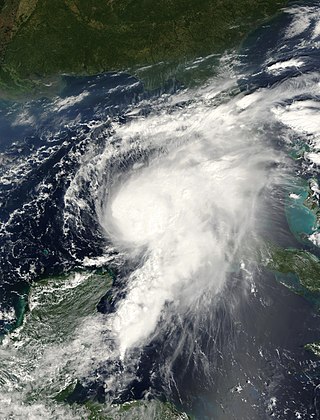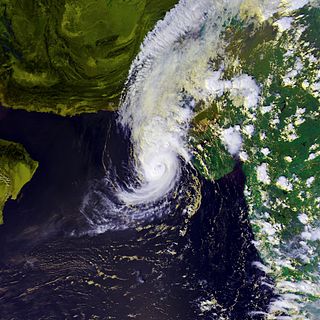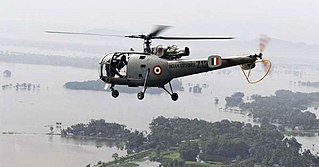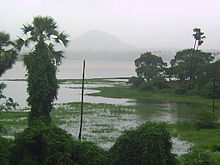
A flood is an overflow of water that submerges land that is usually dry. In the sense of "flowing water", the word may also be applied to the inflow of the tide. Floods are an area of study of the discipline hydrology and are of significant concern in agriculture, civil engineering and public health. Human changes to the environment often increase the intensity and frequency of flooding, for example land use changes such as deforestation and removal of wetlands, changes in waterway course or flood controls such as with levees, and larger environmental issues such as climate change and sea level rise. In particular climate change's increased rainfall and extreme weather events increases the severity of other causes for flooding, resulting in more intense floods and increased flood risk.

Hurricane Mitch was the second-deadliest Atlantic hurricane on record, only after the Great Hurricane of 1780 which killed at least 22,000 people. Hurricane Mitch caused 11,374 fatalities in Central America in 1998, including approximately 7,000 in Honduras and 3,800 in Nicaragua due to cataclysmic flooding from the slow motion of the storm. It was the deadliest hurricane in Central American history, surpassing Hurricane Fifi–Orlene, which killed slightly fewer people there in 1974.
The Climate of Mumbai is a tropical, wet and dry climate. Mumbai's climate can be best described as moderately hot with a high level of humidity. Its coastal nature and tropical location ensure temperatures do not fluctuate much throughout the year.

Santacruz or Santa Cruz is a suburb of Mumbai. The Santacruz railway station on the Mumbai Suburban Railway, the domestic terminal (T1) of the Chhatrapati Shivaji Maharaj International Airport, and one campus of the University of Mumbai, are all located in Santacruz (East).

A cloudburst is an extreme amount of precipitation in a short period of time, sometimes accompanied by hail and thunder, which is capable of creating flood conditions. Cloudbursts can quickly dump large amounts of water, e.g. 25 mm of the precipitation corresponds to 25,000 metric tons per square kilometre. However, cloudbursts are infrequent as they occur only via the orographic lift or occasionally when a warm air parcel mixes with cooler air, resulting in sudden condensation. At times, a large amount of runoff from higher elevations is mistakenly conflated with a cloudburst. The term "cloudburst" arose from the notion that clouds were akin to water balloons and could burst, resulting in rapid precipitation. Though this idea has since been disproven, the term remains in use.

The Mithi River is a river on Salsette Island, the island of the city of Mumbai, India. It is a confluence of tail-water discharges of the Powai and Vihar lakes. The river is seasonal and rises during the monsoons. The overflowing lakes also contribute to the river flow, which is stopped by a dam at other times. During this season, the gutter is a favourite with anglers, who can catch large fish that have escaped from the lakes. Chattrapati Shivaji Maharaj International Airport is located right next to the section of river at Andheri (E).
The Brihanmumbai Stormwater Disposal System is a project planned to overhaul Mumbai's water drainage system. The estimated budget for implementing the project is Rs. 12 billion as of August 2005. Such a high-budget project would require funds from the Central Government. Mumbai has a drainage system, which in many places, are more than 100 years old, consisting of 2,000 km of open drains, 440 km of closed drains, 186 outfalls and more than 30,000 water entrances. The capacity of most of the drains is around 25 mm of rain per hour during low tide, which is exceeded routinely during the monsoon season in Mumbai, which witness more than 1400 mm during June and July. The drain system works with the aid of gravity, with no pumping stations to speed up the drainage. Most of the storm water drains are also choked due to the dumping of garbage by citizens. Portions of Mumbai like Bombay Central and Tardeo remain below sea level. Reclamation of ponds and obstructions in drains due to cables and gas pipe exacerbate the problem.

The Bandra Kurla Complex is a business and residential district in the city of Mumbai, India. It is a prominent upscale commercial hub which commands some of the highest property rates in the country. According to MMRDA, the complex is the first of a series of "growth centres" created to "arrest further concentration" of offices and commercial activities in eastern parts of Mumbai. It has aided to decongest the CBD in South Mumbai while seeding new areas of planned commercial real estate in the metropolitan region.
Drainage in New Orleans, Louisiana, has been a major concern since the founding of the city in the early 18th century, remaining an important factor in the history of New Orleans today. The central portion of metropolitan New Orleans is fairly unusual in that it is almost completely surrounded by water: Lake Pontchartrain to the north, Lake Borgne to the east, wetlands to the east and west, and the Mississippi River to the south. Half of the land area between these bodies of water is at or below sea level, and no longer has a natural outlet for flowing surface water. As such, virtually all rainfall occurring within this area must be removed through either evapotranspiration or pumping. Thus, flood threats to metropolitan New Orleans include the Mississippi River, Lake Pontchartrain, canals throughout the city, and natural rainfall. Artificial levees have been built to keep out rising river and lake waters but have had the negative effect of keeping rainfall in, and have failed on numerous occasions.

The 2006 North Indian Ocean cyclone season had no bounds, but cyclones tend to form between April and December, with peaks in May and November. These dates conventionally delimit the period of each year when most tropical cyclones form in the northern Indian Ocean.

Hurricane Gordon caused minor damage in the Eastern United States. The seventh named storm and fourth hurricane of the 2000 Atlantic hurricane season, Gordon developed in the extreme western Caribbean Sea from a tropical wave on September 14. Shortly thereafter, the depression moved inland over the Yucatán Peninsula and later emerged into the Gulf of Mexico on September 15. The depression began to quickly organize, and by early on September 16, it was upgraded to Tropical Storm Gordon. After becoming a tropical storm, Gordon continued to intensify and was reclassified as a hurricane about 24 hours later; eventually, the storm peaked as an 80 mph (130 km/h) Category 1 hurricane. However, southwesterly upper-level winds caused Gordon to weaken as it approached land, and it was downgraded to a tropical storm by late on September 17. At 0300 UTC on September 18, Gordon made landfall near Cedar Key, Florida as a strong tropical storm. After moving inland, Gordon rapidly weakened and had deteriorated to tropical depression status by nine hours later. Later that day, Gordon merged with a frontal boundary while centered over Georgia.

Dahisar River is a river on Salsette island that runs through Dahisar, a suburb of Mumbai, India. It originates in the Tulsi Lake in Sanjay Gandhi National Park in the northern reaches of the city. The River flows roughly North-West for a total of 12 kilometres through the localities of the National Park, Sri Krishna Nagar, Daulatnagar, Leprosy Colony, Kandar Pada, Sanjay Nagar, and Dahisar Gaothan before meeting the Arabian sea via the Manori Creek. Its total Catchment area is 3488 hectares.

Typhoon Matsa, known in the Philippines as Typhoon Gorio, was the second of eight Pacific tropical cyclones to make landfall on China during the 2005 Pacific typhoon season. The ninth tropical storm and fifth typhoon of the season, Matsa developed on July 30 to the east of the Philippines. Matsa intensified as it tracked northwestward, and attained peak 10-minute sustained winds of 150 km/h (93 mph) near Taiwan before weakening and striking the Chinese province of Zhejiang on August 5. The system continued northward into the Yellow Sea, and on August 7 Matsa became extratropical after again moving ashore along the Liaodong Peninsula. Matsa is a Laotian name for a lady fish.

The 1996 North Indian Ocean cyclone season featured several deadly tropical cyclones, with over 2,000 people killed during the year. The India Meteorological Department (IMD) – the Regional Specialized Meteorological Center for the northern Indian Ocean as recognized by the World Meteorological Organization – issued warnings for nine tropical cyclones in the region. Storms were also tracked on an unofficial basis by the American-based Joint Typhoon Warning Center, which observed one additional storm. The basin is split between the Bay of Bengal off the east coast of India and the Arabian Sea off the west coast. During the year, the activity was affected by the monsoon season, with most storms forming in June or after October.

Severe Cyclonic Storm Onil was the first tropical cyclone to be named in the northern Indian Ocean. Forming out of an area of convection several hundred kilometres southwest of India on October 1 2004, Cyclone Onil quickly attained its peak intensity on October 2 with winds of 100 km/h (60 mph) and a barometric pressure of 990 mbar. However, dry air quickly entered the system, causing it to rapidly weaken to a depression just off the coast of Gujarat, India. Over the following several days, the system took a slow, erratic track towards the south-southeast. After turning northeastward, the system made landfall near Porbandar on October 10 and dissipated shortly thereafter.

The 1996 Oman cyclone was a tenacious and deadly system that caused historic flooding in the southern Arabian Peninsula. It originated from a disturbance in the Gulf of Aden, the first such tropical cyclogenesis on record. After moving eastward, the system interacted with the monsoon trough and became a tropical storm on June 11. Later that day, it turned toward Oman and struck the country's southeast coast. It weakened over land, dissipating on June 12, although it continued to produce rainfall – heavy at times – over the next few days.

Following heavy rain in July 2017, the Indian state of Gujarat was affected by severe flooding. The floods were reported to have caused total 224 deaths between 1 June and 31 July 2017. 16 people had died in neighbouring Rajasthan state by 31 July.
Widespread monsoon flooding occurred in the South Asian countries of Afghanistan, Bangladesh, India, Nepal and Pakistan from July through September 2017. More than 45 million people were affected by the floods, including 16 million children.

Climate change in the Philippines is having serious impacts such as increased frequency and severity of natural disasters, sea level rise, extreme rainfall, resource shortages, and environmental degradation. All of these impacts together have greatly affected the Philippines' agriculture, water, infrastructure, human health, and coastal ecosystems and they are projected to continue having devastating damages to the economy and society of the Philippines.

Extremely Severe Cyclonic Storm Tauktae was a powerful, deadly and damaging tropical cyclone in the Arabian Sea that became the strongest tropical cyclone to make landfall in the Indian state of Gujarat since the 1998 Gujarat cyclone and one of the strongest tropical cyclones to ever affect the west coast of India. The second depression, first cyclonic storm, first severe cyclonic storm, first very severe cyclonic storm, and first extremely severe cyclonic storm of the 2021 North Indian Ocean cyclone season, Tauktae originated from an area of low pressure in the Arabian Sea, which was first monitored by the India Meteorological Department on May 13. The low drifted eastward and organized into a deep depression by May 14. The storm soon took a northward turn, continuing to gradually intensify because of warm waters near the coast, and the system strengthened into a cyclonic storm and was named Tauktae later that same day. Tauktae continued intensifying into May 15, reaching severe cyclonic storm status later that day. Tauktae began to parallel the coast of the Indian states of Kerala, Karnataka, Goa and Maharashtra, before rapidly intensifying into a very severe cyclonic storm, early on May 16. Early on May 17, Tauktae intensified into an extremely severe cyclonic storm, reaching its peak intensity soon afterward. Later that same day, Tauktae underwent an eyewall replacement cycle and weakened, before restrengthening as it neared the coast of Gujarat, making landfall soon afterward.

















